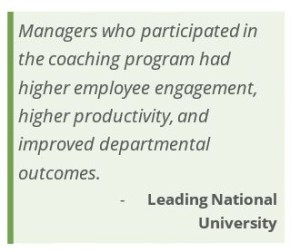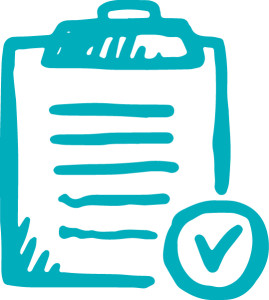How do you coach great employees? First, it’s important to acknowledge that employees, even the best ones, can do with some coaching.
But your company hired someone with a carefully detailed resume, who interviewed well and appeared to be a positive addition to the team and culture. Most likely, the candidate didn’t have to demonstrate a variety of high-performance skills that are mission-critical to day-to-day work. It’s only later that you’ll learn how well his or her resume comes to life. For example:
- Does the employee foster strong relationships with customers?
- Does he or she deliver compelling presentations?
- How well will the employee implement cost-savings initiatives?
Thorough hiring practices can only do so much. Time and circumstances are the true test. Luckily, your company can solve most discovered performance gaps through effective coaching.
What is Corporate Coaching?
Corporate coaching is the art of inspiring and motivating employees to achieve specific goals. This coaching method focuses on the employees’ development and how they can use their personal growth and new skills to make the organization more successful.
Corporate coaching is unlike instructor-led classroom learning. An ideal coaching session gives employees the tools to be more productive and meet objectives without putting undue stress on them. Corporate coaching can begin at the top of the organization or with high potential employees and other employee groups. A corporate coach helps an individual employee learn and unlock their own potential.
Advice on How to Coach Great Employees
Organizations embrace coaching to different degrees, but there are always steps you can take to improve the hiring process, retain talent, and ensure your company remains competitive.
Remove Any Stigma From Coaching
One of the greatest drawbacks to effective coaching? People often don’t like admitting weak areas so they tend to rationalize important skills (communication, organization, presentation abilities) as not essential to their role.
You might hear an employee say, “I’m a marketing guy, not a professional speaker.” However, that still leads to a diminished overall professional “score” and a less effective employee. The truth is, great employees aren’t just hired – they achieve greatness through ongoing personal development, which you can foster through coaching.
In a perfect business culture, when poor performance is observed, there should be a productive path to explore ideas for improvement. However, another limiting belief, “feedback is corrective,” can lead to managers who are disciplinary rather than developmental. As a result, full-feedback disclosure is usually only reserved for the semi-annual performance review or an uncomfortable meeting. There are more productive options.
Make Coaching Part of the Culture
According to Bersin and Associates, organizations with excellent cultural support for coaching have 13 percent stronger business results.1 Why is this? When two people communicate in a collaborative spirit and brainstorm options for an improved future, there is deeper engagement, greater trust, and measurable progress.
Although companies hope to hire magic employees who can perform all facets of their jobs superbly, the reality is that employees often have talent gaps. The solution: coaching your great employees.
For example, you might have an employee who’s a clear communicator in small meetings – but fumbles when he stands before an audience of 30 people. If your company needs strong presenters to pitch products to new business channels, this becomes a problem. However, this is easy to remedy if your organization embraces coaching. With coaching, you already have a ready-made path to support the employee and develop skill.
That’s why it’s so valuable for organizations to possess strong learning cultures. When organizations encourage coaching, employees are no longer as concerned about how they’re perceived. Instead, they realize they’re encouraged to find solutions for moving their performance from good to great.
The Coaching Mindset
Coaching involves both a mindset and a skillset to be most effective. If the coaching opportunity isn’t handled properly, it will lose steam and prove unproductive. All business is show business, and taking a moment to think through your individual roles and “get into character” is essential.
Developing a growth mindset is the first step because it drives the entire framework, from setting the agenda to identifying the end result. Furthermore, the mindset should be curious rather than intense to drive a developmental agenda. Although it is frequently the coach’s intention to do a good job and push for results, it can feel threatening to the coachee who must sit back and become a part of the coach’s plan, rather than be at the center of the agenda.
Coaching is a collaborative discovery process and the opportunity to identify solutions should be deferred to the coachee, with the coach offering guidance and commentary where appropriate. The coach should take an interest, not a position, and use communication skills to draw out the best ideas.
A coachee can relax and recognize the reality that, as they say in the south when you’re inside the jar, you can’t read the label.
The Coaching Skill Set
Frequently, coaches believe their role is to serve as an inspiration. When the coachee struggles with an issue, it’s tempting to jump into the conversation with personal anecdotes. But coaching great employees isn’t about presenting a list of options to the coachee; it’s about drawing out possible solutions and adding ideas where needed. An open-ended question such as “What are some ideas that may help you better navigate ‘x’”? is more productive than providing options; moreover, asking, rather than telling, helps the coachee feel ownership over the idea.
Both parties should understand that coaching is a process, not an event. Improved performance outcomes require regularly scheduled coaching meetings. Most importantly, both the coach and the coachee should be accountable for the next steps. When the coach offers to locate a resource, there must be follow-through. When the coachee agrees to improve a skill (preparation, listening skills), the coach should specifically seek to observe improvements in those areas.
Since coaches don’t need to be subject matters experts on every skill, there should never be a shortage of people willing to step up and participate in the established coaching process. Draw from an internal coaching pool, reliable external coaches, or set up a mentoring program to make all of your employees coach and develop the learning culture.
15 Tips for Creating a Successful Corporate Coaching Program
A study from Bersin and Deloitte recently found that organizations with “excellent cultural support for coaching had a 75% higher rating for talent management results than those with no or weak support for coaching. Further, they had 13 percent stronger business results and 39 percent stronger employee results.
The more cultural support for coaching, the stronger the results.”* To help you get started, we’ve gathered up our best practices advice and summed it up in 15 key ingredients that you can use as you develop your own organization’s recipe for successful coaching programs.
1. Define clear goals and objectives
Without a clear goal it is impossible to know where you are heading or whether or not you ever arrive. Having specific program goals (overarching priorities) and defined objectives (specific targets) is like having a precise destination and good directions.
For example, the program goal (overarching priority) might be to prepare middle managers for advanced leadership positions. As a result, the one defined objective (specific target) might be to improve participating middle managers’ abilities in motivating and inspiring others toward a shared vision and strategy.
The best goals are ones that are created in partnership with key program stakeholders. Whose buy-in do you need for the program to be successful? Involve representatives from these key groups in the early stages of program planning. These representatives will in turn become your program champions because they have a stake in the program’s success.
2. Secure leadership support
While program objectives provide a clear direction for your coaching participants, the support of top-level leadership makes it easier to achieve those objectives. To get help from senior leadership, you need to get them to buy-in to the program. You can do this by explaining how the program will contribute to the achievement of strategic objectives.
A senior manager or member of the C-suite who believes in the coaching program will be a good ambassador. This person will be a vital resource, helping to demonstrate and vocalize the program’s intrinsic value and acknowledging how its benefits outweigh its cost. Leadership support will also facilitate the approval and expansion of budgetary allocations for the coaching program.
3. Find a strong program administrator
Choosing an optimal program owner or administrator is essential for coaching program success. While having an effective admin is not enough to guarantee success, an ineffective admin will undermine the hard work and resources you put in to make the coaching program succeed.
Good program admins prioritize effective training and support to the participants. They are adept at identifying opportunities for improvement and troubleshooting problems that might arise for coaches or coachees, or while working with stakeholders to ensure that the program fulfills its objectives.
When looking for a good program manager, search for someone with experience as an administrator. But if you can’t find someone with such expertise, ensure you choose someone who has a passion for the program’s goals and the organizational and communication skills needed to succeed.
4. Choose coaches who fit your goals
Establish guidelines when selecting coaches. Determine the experience, skills and possibly tenure you’d like coaches to have in order to make them effective. Think carefully about your company’s vision, mission and values. Do the coaches you have in mind have the skills and expertise to uphold and instill these values in their coachees?
Coaching is a personal experience. You need to take the time to find people prepared to understand your company’s strategic plans and objectives and help employees meet these goals. A good coach will align their guidance and methodology with your employee’s skill acquisition needed to produce the best outcomes.
5. Build flexibility into your corporate coaching program
To train your team members effectively, you need to maintain a balance between structure and flexibility. It’s essential to have a structure for training, communicating with participants, and tracking their progress.
However, coaching and mentoring employees must take into account their learning styles and personal career goals. Participants will have preferred methods of receiving information, leading coaches to utilize varied coaching styles to produce outcomes.
When you create a career development coaching program, build-in room that will allow participants to adapt the program to their learning styles, schedules and preferences. Components that should be flexible include the program setting (group discussions, or one-to-one coaching), timeframe for formal training, interactive elements, and types of training for participants.
6. Target coaching populations at mid-level to increase impact

When a leading national university faced increasing economic challenges and the need to make significant operational changes, it invested its limited resources in leadership development and coaching for mid-level managers. In its evaluation of program results, the university found that those managers who participated in the program had higher employee engagement scores, higher productivity, and improved departmental outcomes. In addition, more than 30% of the coached managers advanced to more senior positions in the organization.
7. Craft compelling communication to promote your coaching program
For coaching programs to be effective, they must be high-profile development activities that engage your best talent. Even in instances where the development is a top down activity, it is important that the target audience understand the coaching program and why they should be a part of it. Crafting compelling communication for dissemination in a variety of vehicles – staff meetings, success stories shared via email, etc. — will ensure that talent is enthusiastic and committed to coaching. This sets the stage for the best possible outcomes.
Get mentoring resources straight to your inbox. Subscribe today!
8. Involve talent in the coach selection process
Effective coaching hinges on a strong relationship between coach and employee, a relationship born of respect and trust. In order to create the most fertile ground for this kind of relationship it is recommended that employees have some level of participation in the coach selection process. If possible, provide employees with a small, select pool of potential coaches, and let them make the final decision. To create impactful and lasting learning, a positive coaching relationship with great chemistry is essential.
Online tools, such as Chronus software, can provide a valuable means of effective matching, allowing employees to search through available coaches by region, areas of expertise, and other relevant criteria. Software also enables program managers to track coach availability and make coach recommendations based on potential compatibility.
9. Establish clear expectations of a particular engagement
Successful corporate coaching programs are about clarity, learning and action. In order to set the stage for effective coaching engagements, it is important that the coach and employee refine the development focus. While leadership may identify a broader skill area such as “influence,” it is up to the employee and coach to identify which elements of influence would be the most effective focal areas. Such refinement is essential for development planning and establishing clear success measures.
10. Include participant training
Effective coaching includes a mix of training sessions and workshops to make sure participants are prepared to coach and be coached. Coaches can offer insights, information, and inspiration that will help employees achieve peak performance. This can result in organizational transformation within the company.
During training, participants should learn how to open up to coach about challenges and to receive feedback and guidance in actively finding solutions. Part of this process is understanding how to communicate and collaborate effectively.
Workshops and seminars should be an integral part of training sessions. Presentations improve the understanding of new concepts and expose participants to ideas they’ve never thought about before. Training participants will set them up for success in the coaching program, enabling attitudinal change in the organization.
11. Effectively manage, track, and measure progress
Wide-scale coaching programs require regular administrative oversight to ensure they are effectively managed. It is important to know if connections have been established, coaching engagements are taking place and progress is being made. This critical step will help you make program adjustments and broadcast program success later.
Use coaching software to help you effectively track coaching engagements and measure progress. Embedded reporting functionality can provide engagement metrics and online survey tools can ensure managers have real-time feedback from employees and coaches regarding results.
12. Continuously refine your program in response to feedback
Don’t wait until the coaching engagements have come to an end before finding out how things are going. By getting regular feedback from program stakeholders plus participants and their coaches—through survey tools described above—you can identify any problems, misunderstandings, or subtle misalignments. Sometimes, the smallest programmatic adjustments can have a huge impact on the overall efficacy of the coaching program.
13. Communicate throughout the course of the program
As George Bernard Shaw so astutely reminds us, “the single biggest problem in communication is the illusion that it has taken place.” Be sure to communicate regularly with employees in coaching engagements, with coaches, with program stakeholders, and to the organization overall regarding your important investment in talent development.
While such regular communication can seem daunting, if you manage your program online, you can easily provide valuable progress metrics and streamline communication to keep the program visible and on track.
14. Evaluate impact

To truly understand impact, gather input from additional sources outside of the program participants. What do their direct reports say? What do their managers say? The use of online survey tools can help you easily gather and analyze this information. Additionally, evaluate other departmental metrics—such as increased sales, reduced cost, increased productivity, etc. — to evaluate the impact of the coaching program.
15. Share your corporate coaching successes
Sharing success stories is one of the most effective ways of motivating and inspiring others—whether you are seeking to expand coaching program reach, ensure leadership commitment, or even strengthen the reputation of the HR or learning and development function. Effective success stories show benefit, provide a memorable fact/truth, provide metrics, include an emotional hook, and create a sense of urgency. Coaching program participants are the best source of these stories and also can serve as one of the best means of getting these stories out into the organization. Profile participants’ experience in a video on the company blog, have them participate in noontime panel discussions, or post their stories on the walls of the cafeteria. Be creative and get these stories heard.
Conclusion
Now that you’ve learned about the 15 key ingredients for creating a successful corporate coaching program, it is useful to consider employing a program management tool, such as Chronus software, to lessen the administrative effort and expense. Best of luck to you and your program!
Download our “How Coaching & Mentoring Can Drive Success in Your Organization” whitepaper
